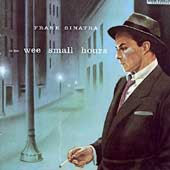
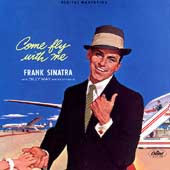
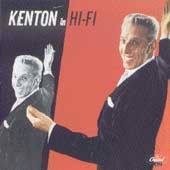
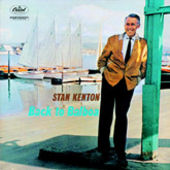
The first part of the interview is about the company, Capitol Records, it's facilities, technology, and marketing practices.
Capitol Records History
Nori: When you were working for Capitol [1953 - 1961], when you started there, how did it rank compared to other record companies?
Don: Capitol was the up and comer record label. Capitol was the label that had really hip artists. At that time 1953-54, the two biggest labels were RCA and Columbia Records. They were neck and neck for having the most hit records. Capitol was in third place and basically tied with a company called Decca, which was not connected to British Decca. It was just a separate company. Decca Records had Bing Crosby, which made them a very big factor in the industry. Everything Bing Crosby made sold like crazy. He was a very popular vocalist. Then there were some independent labels that had hits now and then. Mercury Records was around then. There were smaller ones even than that. There were companies that were selling rock 'n roll records, Motown, and records like that. The big two were Columbia and RCA, followed closely by Capitol and Decca. One of the things about Capitol artists was that they were somehow the most interesting and most impressive new people. Kay Starr, the singer, came on like gang busters in those days. Of course they signed Frank Sinatra when he was at the bottom of his career. After he appeared in the movie, "From Here to Eternity," and signed with Capitol, Frank Sinatra's career took off, really for the second time. He had a single record called "Young at Heart" that was a big hit, then a bunch of great albums. Of course, Capitol kept selling more and more stuff.
Nori: When did Capitol sign Frank Sinatra?
Don: I would guess it was probably either late 54 or early 55, something like that. His hit called "Young at Heart," was number 2703, and Les Paul and Mary Ford's "Vaya Con Dios" was 2486 and that came out right about August or Sept. of 53. So Sinatra was in there right around the mid-50s. I'll tell you the other thing about Frank's albums. He was hitting huge and drawing crowds in Vegas at that time, and with arrangements by Nelson Riddle and Billy May, his albums really flew off the shelves.
Nori: Capitol started in Hollywood, right?
Don: At the beginning Capitol was all decentralized. The first Capitol office was at 1507 Vine Street, which was a second floor facility above a big record store called Music City. That record store was owned by Glenn Wallichs, who was also the president of Capitol Records. Actually, Capitol got started during the war because Glenn Wallichs with his record store connection was able to get a lot of used shellac, which you couldn't get during the war. That used shellac could be melted down and turned into new records. So Glenn Wallichs got enough used shellac that he could make new records out of them. He and Buddy deSylva and Johnny Mercer started Capitol Records. That was probably about 46, 47, 48, something like that.
Nori: Do you know why they chose that name?
Don: Yeah, Hollywood was considered the entertainment capitol of the world. The logo looked like the Capitol dome in Washington, but it really meant the entertainment capitol. I'm sure that's where it came from. Johnny Mercer and Buddy deSylva were song writers and Johnny Mercer was also a singing artist. They didn't really have an active position in Capitol Records. It was Glenn Wallichs and the management team that really got Capitol off and running. Because the company grew so much, there wasn't room in those offices on Vine Street for everything, so they bought a recording studio down on Melrose. The area where they did data processing and so forth was over on Hollywood Boulevard, in a rented office space there. They had another building somewhere, plus of course distributing company branches all over the country. There was a New York office at 55th Street and Broadway. A pressing plant in Scranton, Pennsylvania, and in Los Angeles at Hyperion and the Golden State (also known as the 5 Freeway, or Highway 5). So Capitol was decentralized until late 1956 when the Capitol tower opened. Then everything went in there. There were recording studios, there, data processing facilities, photographic facilities for album covers. Everything was consolidated in the Tower, except the pressing plant was still elsewhere. The world headquarter of Capitol was there. That was about the same time Capitol got bought out by EMI of England and since then Capitol has been owned by EMI.
Nori: Is that how they got the Beatles?
Don: That's how they got the Beatles, yep. The Beatles were recording on HMV ["His Master's Voice," one of many EMI labels], and Capitol had the good sense to pick up their contracts for the U.S. Capitol passed up on Elvis Presley before RCA got him. Unfortunately for Capitol. It was about 1952 when Col. Parker took Presley to Capitol to try to get them to make a contract for him, and they didn't. So RCA got Elvis Presley, and a whole load of records of his.
Nori: Would you tell me more about the people who were running Capitol?
Don: Glenn Wallichs was the president. He was a kind of benign, rather low-key, straight ahead guy. He didn't have a whole lot of drive, as I recall, but on the other hand he wasn't an unreasonable person. He was pretty friendly to everyone. Of course, he was the manager of the corporation. Below him there was a manager of production, a guy named Dan Bonbright, who was in charge of getting all the records made and out and into the distributing branches. There was a marketing manager in charge of advertising and sales named Lloyd Dunn. There was an A&R manager, the guy in charge of artists and recording, whose name was Alan Livingston (he was married to Betty Hutton). Let's see, who else am I forgetting? Well, those were the main guys. They were pretty intelligent and pretty forward looking individuals. At least the A&R guys were, I'm not sure the marketing department was quite as forward-looking by today's standards. They were a little stodgy in some ways. Having peculiar reactions against, sort of like the Japanese concept, if any nail sticks out too far, hammer it down, so to speak. I think they were more straight laced than the most managements of big corporations would have been. Nobody liked crew cuts, you weren't supposed to smoke a pipe, two or three other things. Beards. There were unreasonable, unwritten kids of things. It was part of the corporate psyche, you might say.
Capitol Facilities
Nori: Where was the recording studio in the building?
Don: Down on the main floor. They're still there, too. Studio A, B, and C are all there. Plus Capitol kept the Melrose facility for a long time. I don't know if they still own it or not, but when we were first there before the tower was built, we heard at least one session down there on Melrose with Frank Sinatra, where they invited us to come in and sit in. There was a studio where there was auditorium seating for a couple of hundred people and a bunch of employees got to come and listen to Sinatra record some stuff. It was really a great experience.
Paula: I was there and so was Nori, but she was inside.
Nori: I saw Frank Sinatra before I was born?
Paula: Yep.
Nori: Cool.
Paula: I don't know how much you could see.
Nori: Well, hear.
Paula: Hear, yeah.
Capitol Recording Technology
Nori: What kind of equipment did they use to record back then?
Don: The main recording masters were made on Ampex quarter-inch tape on big Ampex tape recorders that used what they called pancakes. It was a 15-inch wide roll of quarter-inch tape that would sit on a console parallel to the floor and they had a head stack right in the middle and they ran at 15 inches per second. So these tapes, well even some of these tapes ran at 30 inches per second, but 15 became the standard while I was there. Fifteen inches per second compared to a cassette, which runs at about 1-7/8 is pretty fast, that meant they could get the highest [quality]. In those days, magnetic tape quality was dependent on tape speed. The faster the tape speed, the better the quality. In order to get maximum quality, quality good enough so you could almost make it sound like a live performance you had to use a fast tape speed. Most of those masters were made at that speed and were stored that way, and probably still are. There were only two channels, by the way. One channel to start with, and then stereo came in, which was right about the early 50s. Tapes were recorded in stereo. Now, of course, tapes are recorded in multiple tracks with digital boards and digital input.
Nori: That's what I was going to ask you. How did the quality compare to digital?
Don: Not as good. The frequency response was limited to probably about 18 kilohertz, which is higher than people can hear but there would be a restriction in overtones, transients wouldn't always sound as good. The dynamic range of tapes was much less than it became after the Dolby system took over. The Dolby system took over probably in maybe in the mid-60s. They started adding Dolby processors to master tapes in those days. But that wasn't all. The mixing boards in those days were vacuum tubes, not transistors. That didn't come about until later on, probably in the 60s. The microphones weren't nearly as sensitive or as good, although they used condenser mikes and ribbon mikes mostly, for good recording in the studio. There was some standard electromagnetic mikes, but they just didn't have the crisp quality. But then the L.P.s in those days - and everything was coming out on 33-1/3 - the L.P.s didn't require that much quality because the L.P. format didn't give you that much capability compared to a CD or even a cassette. Cassette tapes were definitely a step up from L.P.s.
Nori: What kind of mixing did they do?
Don: They had two tracks in and they put them on one track on each half of the quarter-inch tape. Of course later on they went to half-inch tape and then they went to one-inch, then everything just exploded from that. But those early ones were quarter-inch tapes with a track on each side, so they were straight stereo. Basically, what they were doing in the studio in a lot of cases was just putting two mikes in a convenient place. Now with big orchestras and orchestras and vocalists and other things they would use many more microphones, then they would mix them down in the board so that the two tracks that came out sounded as near to the live studio sound as they could get. But that was quite primitive to compared to what's happening today where every single instrument is on a different track, every track is laid down separately.
Nori: Or they lay tracks down after the fact. Did they ever do that?
Don: Yeah, there was some of that one, where there would be an instrumental track and then the vocal would come in later on and then the vocalist would put headphones on and sit in the studio by themselves and put the vocal over the track. But that kind of recording wasn't near as common then. Then, right then, after the master tape was made, and they were happy with it, they could put the master L.P. disk on a cutting lathe, a great big turntable, that had the proper technology to actually cut the master pressing to go to the plant. They could cut those right there in the studio and send them to the plant, so if we wanted to get an album out in a hurry, it could be done in a matter of days. Compared to albums these days, some artists take two or three months to do an album, or even longer. It didn't take us that long in those days and we didn't need it. We didn't feel it was necessary.
Capitol Marketing
Nori: How many albums did Capitol put out?
Don: A fall release might have 20 or 25 albums by the pop artists, and maybe 5 or 10 by specialty artists of various kinds - ones you couldn't really define as pop, like jazz artists or big bands, or something slightly off [the beaten path] or foreign material, something like that, and at least 10 classical albums.
Nori: Fall, meaning quarterly?
Don: Well the releases were usually semi-annually. There was a fall release, a spring release, and in the summertime there would be a stocking program, but there wouldn't be any new released albums until a little later on. So I think we were releasing albums twice a year in those days.
Nori: So you would have, sounds like 30 or 50?
Don: Might have been as many as 50. I probably somewhere in my papers have a list of all those - maybe a couple of release lists, or something like that, that would give us some tips. I have some stuff out in the garage that I'll bring in later on and we can look through there.
Looking at Documents
Don (looking through files from Capitol days): Okay, here it is, "Tour talk for tour guides," the repertoire department. Yes indeed, look at this. The executive area, national sales manager, Steve Strohman, legal department and offices, arts and editorial, Fred Rice, production and planning, merchandising, Merrilyn Hammond, Vic Rowland, that's who was in charge of advertising, Ernest Krebs, Don Hassler, Dick Rising, Gordon Fraser. Look at that, well there you go. This was the tour that we gave when the tower opened. All written out here for those of us who did tours.
Paula: Nori was a babe in arms, just born, when I went through the tower and took her with me [I was born Feb.2, 1956].
Don: This was written March 30, 1956. Building diameter is about 92 feet. The gross area in the building is 93,000 square feet, etc., etc., etc., ceilings are 10 feet on all floors except the first. And here's a press release from Capitol News, dated April 2, 1956. I'm going to turn all this over to you Nori. You can go through this and it will supplement what we're talking about. I knew I'd have some of this. Here's a list of all the management people, the directors. Glenn Wallichs, Dan Bonbright. By this time we were part of EMI because this guy, Lockwood, was the boss. He was in London. It tells about the studios down on the first floor. Here's the tour.
Nori: What floor were you working on?
Don: Was it the ninth floor, ninth or tenth.
Paula: You know your dad went out the window and walked around the window on the ledge. There was no fence or anything.

Above: The Capitol Tower located on Hollywood and Vine (photo by Nori Muster, 2003).
Below: Capitol Tower grand opening booklet cover (1956). Go to "50th Anniversary" to see the whole booklet (click here for index).
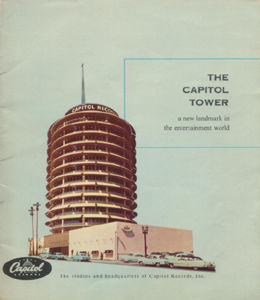
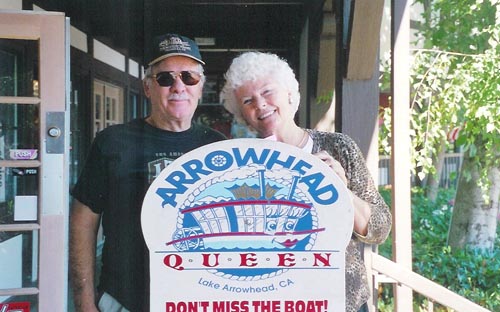
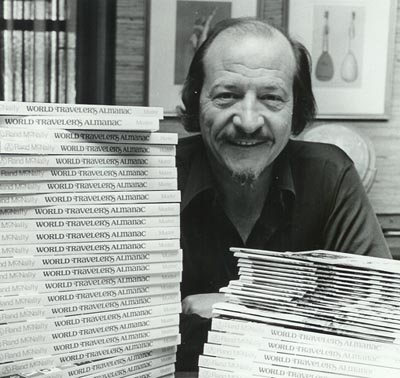
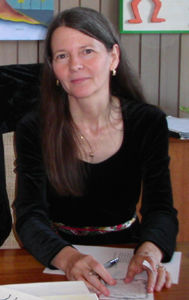
Interviewer, Nori J. Muster: "These are my parents!! Just doing my part to preserve family history!"
Notes
1. Capitol was originally incorporated as "Liberty Records" in April 1942 (I got a copy of the papers from Sacramento with Wallichs', Mercer's and DeSylva's signature), but they were unable to secure the rights to use the name from the Liberty Music Shops in NY. At a dinner at Chasen's, Johnny Mercer's wife Ginger suggested the name Capitol. From what I've been able to find out, Glenn Wallichs came up with the 4 stars above the dome in a patriotic mood as at that time 4 stars was the highest rank in the Army.
2. Frank Sinatra's first recording session for Capitol was held April 2, 1953, but I haven't found a date for when he officially signed with Capitol (yet).
3. Capitol hasn't used the Melrose facility for quite a while. The Melrose studios is now the home of KCAL 9 TV at 5515 Melrose Ave.
Capitol Records Index